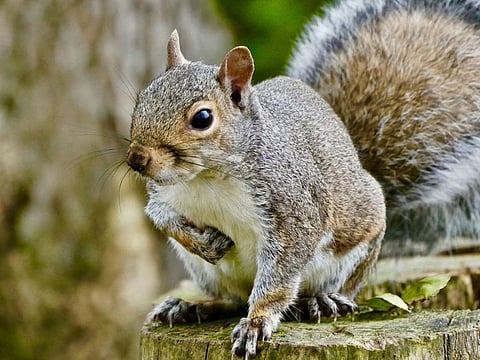Squirrel invasion in Manila raises disease fears
Irresponsible pet owners blamed for proliferation of squirrels in Metro Manila

Manila: Sightings of squirrels have been increasing in Metro Manila and, while children and pet lovers would welcome this development, animal experts are raising alarm.
Squirrels are not native to the metropolis.
According to Dr Teresa Mundita Lim, director of the Association of Southeast Asian Nations (Asean) Biodiversity Centre, their increasing presence could spell bad news for the local animal population.
She said, like other rodents, squirrels are prolific breeders.
A mother could give birth to a litter of up to ten juveniles and there are no known natural predators in urban areas that could keep their population in check, she said in an earlier interview aired by the GMA News.
“They could easily repopulate and displace other animals native to the area,” she said.
There had been numerous sightings of the furry, playful critters as early as 2007 in several posh residential areas of the metropolis.
Although it is yet to be confirmed, it appears that the critters are of the same kind that could be found in the other islands of the country.
The Philippines has its own squirrel species, the Philippine tree squirrel and these can only be found on islands such as Palawan in Luzon, Bohol, Leyte and Samar in the Visayas, and in Siargao in Mindanao. It is still not certain if those sighted in parts of Metro Manila are part of the species found in the country or from abroad.
Disease carriers
Adorable as they may seem, due in part to cartoon depictions of the critters, Mundita-Lim said squirrels in the metropolis are an invasive species.
This means there is a chance that they could displace other animals native to the area in the competition for food or worse, directly prey on other creatures.
Also, the presence of invasive species or non-native wildlife in the ecosystem is raising concerns about disease, amid the coronavirus outbreak in China.
The virus, also known as COVID-19, has killed more than a thousand people in China, and some experts have said it was brought about by the consumption of pangolins.
Rodents such as mice and rats as well as squirrels could also carry diseases.
Dr Juancho Bunyi, assistant health officer of Muntinlupa City, in an article published last January 2019 in the magazine “Animal Scene” said squirrels are rodents and considered pests.
A bite from a squirrel can have complications that could lead to death.
“Whatever we think of them, the lesson is clear: It’s best for both man and squirrel for the former to leave the latter alone,” he said.
Wildlife trafficking
But how does an animal species that is native to another part of the country proliferate in Metro Manila, which ranks among the most dense urban centres in the world in terms of human population?
According to the Department of Environment and Natural Resources (DENR) animal trafficking is to blame for the presence of an apparent increasing number of squirrels in the city and in Metro Manila.
Despite laws against wildlife trafficking, this wrong practice continue.
It is assumed that the squirrels that have been increasingly seen in Metro Manila came from either an irresponsible pet owner or from a number of the critters that had somehow escaped.
Environment Secretary Roy Cimatu reminded the public that keeping wild animals as pets is illegal and could land an offender in jail.
“Collecting, hunting or possessing wildlife species, both flora and fauna, without a valid permit from the government is illegal,” Cimatu said.
There had been similar cases in the Philippines where wildlife kept by owners made it in to the wild and wreaked havoc on the surrounding ecosystem.
Several years ago, authorities faced problems with janitor fish (scientific name: Pterogoplychthys) which had been preying on the local fish population at the Laguna de Bay south of Manila and in the Pasig River in Metro Manila.
The janitor fish, according to reports, were dumped by an irresponsible aquarium owner into the waters, unaware that it could easily multiply.
Sign up for the Daily Briefing
Get the latest news and updates straight to your inbox



